An essential guide to laundry symbols – we decipher the icons and language for a perfect wash every time
Expert guidance to help you understand what the symbols, and therefore washing instructions are on care labels


If your laundry regularly shrinks, discolors, ends up with odd texture or becomes damaged quickly, it might be that the often-confusing care label symbols aren't working well to inform you on how best to wash your items.
To prolong the life of your favorite clothes, towels and linens, our experts, both in-house and laundry and cleaning pros, help decipher the gamut of laundry symbols found on the care labels attached to your items that carry instructions for washing, drying, ironing and bleaching.
So, if you are left stumped by the sheer variety of symbols on your garment care label, you can learn how to do laundry – so your clothes can always look as good as the day you bought them.
An essential guide to laundry symbols
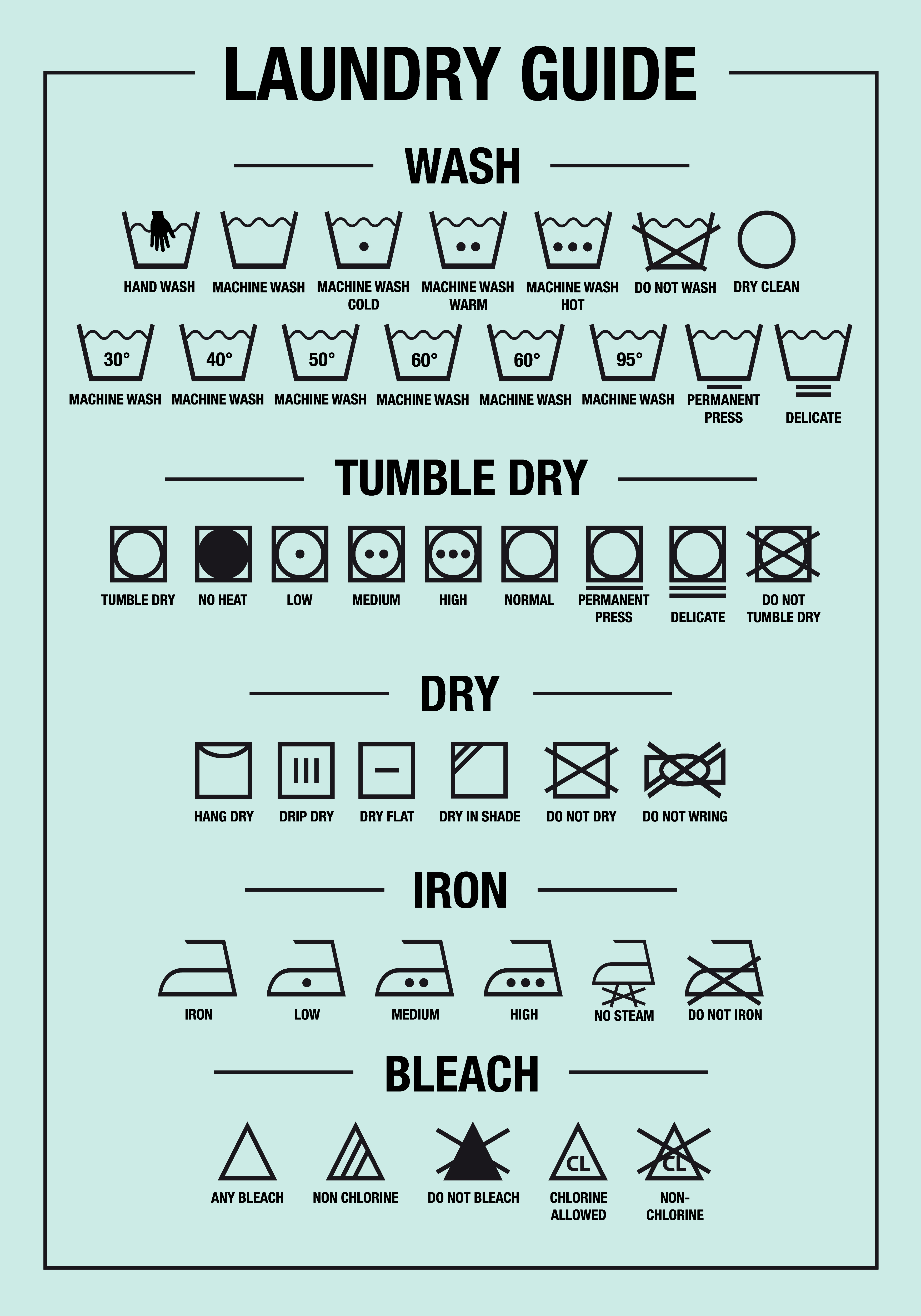
'Always check the label to save you headaches,' advises Jonathon Reckles, vice president at CD One Price Cleaners. 'The biggest risk to garments is when the care label isn't followed, not only to that garment but to others in the same load. Common results could include distortion, shrinkage, and color loss.'
Washing symbols
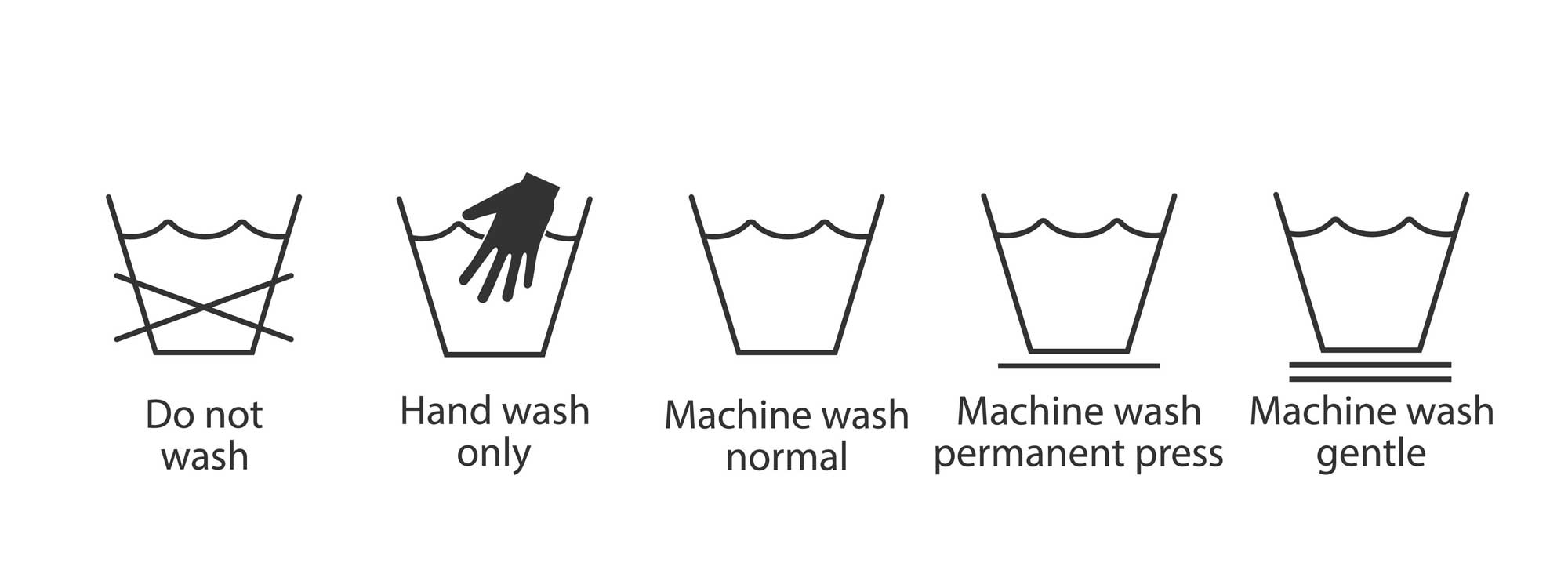
The most important laundry symbols to know are the basic washing instructions. These will usually tell you whether or not something can be washed in a washer, which setting to use or whether it's best hand-washing the item.
- A tub icon with a cross through it (far left above): This means do not wash and is usually found on delicate items and some home wares such as curtains and drapes, denoting that it should not get wet. You will have to have it dry-cleaned instead.
- A tub icon with a hand (second symbol above): This indicates an item should be hand washed. Some of the best washing machines have a hand wash setting that you can use for this if you like, to save you time hand-washing clothes at your sink. Use a delicate detergent, such as the Woolite Delicates Hypoallergenic Liquid Laundry Detergent available at Walmart for the best results and wash at a tepid temperature, unless there is further information on the label about using cold water.
- A tub icon with a wavy line (third symbol above): This means an item can be machine washed as normal.
- A tub icon with a wavy line and single horizontal line beneath (fourth symbol above): This indicates you need to use a permanent press cycle. This is a setting on some washing machines specifically designed to limit wrinkles on fabric that you might not be able to iron.
- A tub icon with a wavy line and two horizontal lines beneath (far right above): This indicates a delicate or gentle cycle is needed, usually for delicate fabrics such as lace and tencel, and smaller clothing items that might be damaged or snagged when agitated too roughly. These are best washed in a delicate laundry bag, such as the bestselling 3Pcs Durable Honeycomb Mesh Laundry Bags for Delicates available at Amazon to protect them from snagging on other items or the machine itself.
Washing temperature symbols
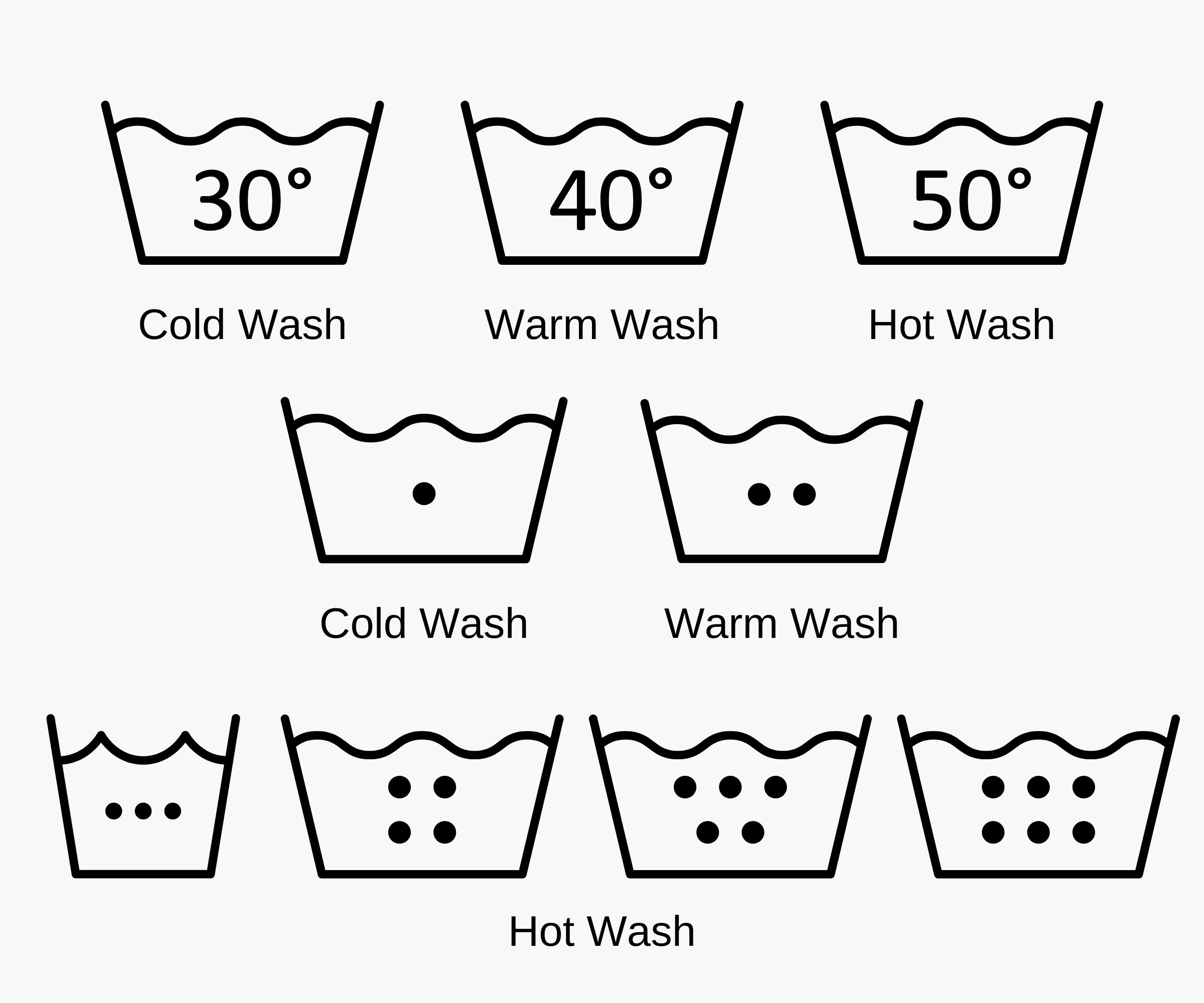
The next most important symbol to understand is the washing temperature guide. This can be displayed in two ways, either by a tub with a written temperature inside of it, or a tub with varying numbers of dots.
Knowing what temperature to wash dark clothes to preserve colors, or what temperature to wash natural fibers to preserve size and shape is vital to preventing damaged clothes. As there are some items you should always wash in hot water, and items you should never wash in hot water, these symbols are key to caring for your clothes.
- A tub icon with a number inside (top row above) will tell you the exact recommended temperature to wash clothes at to prevent damage. For example, '85' means to wash at 85 degrees Fahrenheit, or 30 degrees Celsius.
- A tub with a single dot inside (left, second row above) inside indicates an item should be washed cold at 85ºF (30ºC).
- A tub with two dots (right, second row above) indicates a warm wash temperature of 105ºF (40ºC).
- A tub with three dots (far left, third row above) shows a warm/ hot wash of 120ºF (50ºC).
- A tub with four dots (second symbol, third row above) means a hot 140ºF (60ºC) wash.
- A tub with five dots (third symbol, third row above) indicates a 160ºF (70ºC) wash.
- A tub with six dots (far right, third row above) indicates a 175ºF (80ºC) wash.
Dry cleaning symbols
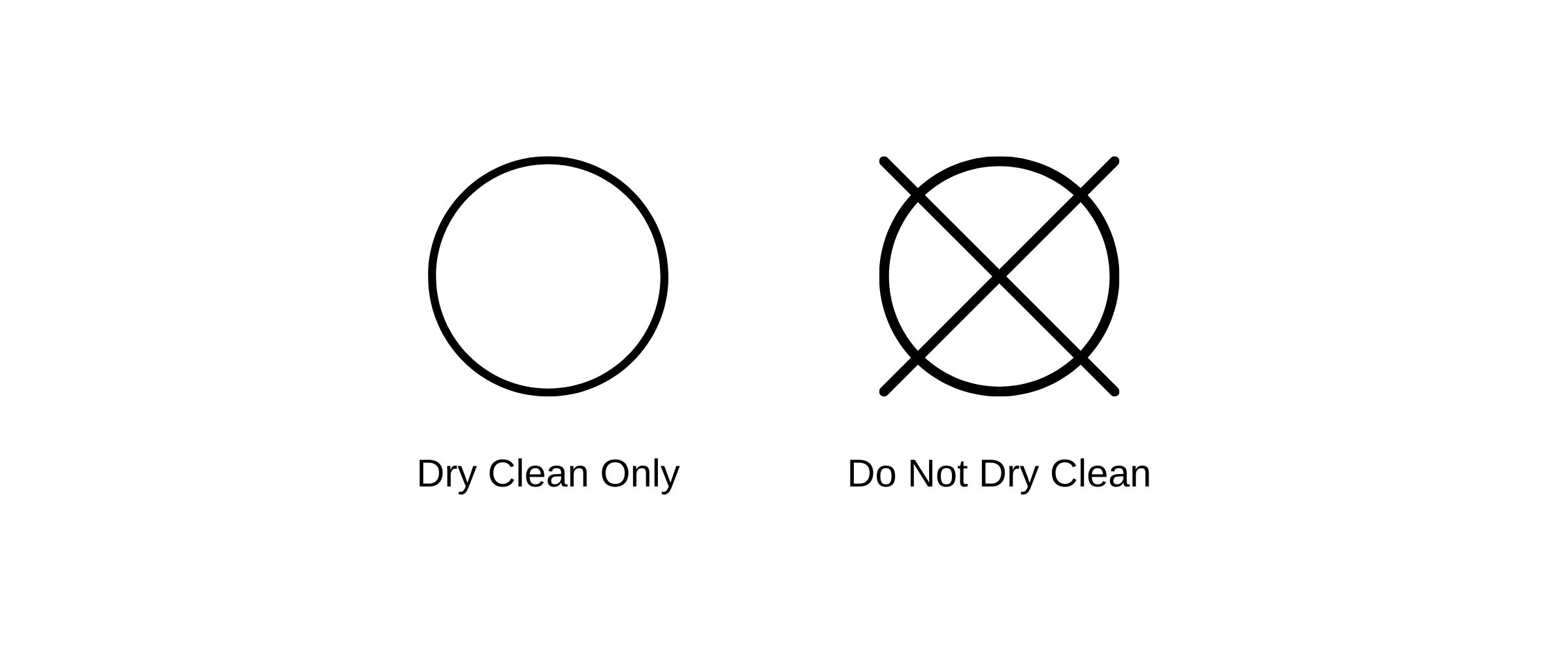
Not all garments can be washed at home in your washing machine. Some items with delicate or natural fabrics may require dry cleaning to preserve the shape, size, color, or texture.
While you can learn how to dry clean clothes at home, using a dry cleaning kit such as the dryel at-Home Dry Cleaner Starter Kit available at Amazon, if you are concerned always drop your items off with a professional.
- An empty circle (left, above) means the garment needs to be professionally cleaned.
- A circle with a cross through it (right, above) means the item should never be dry cleaned, as the chemicals used in the process could damage the garment.
Drying symbols
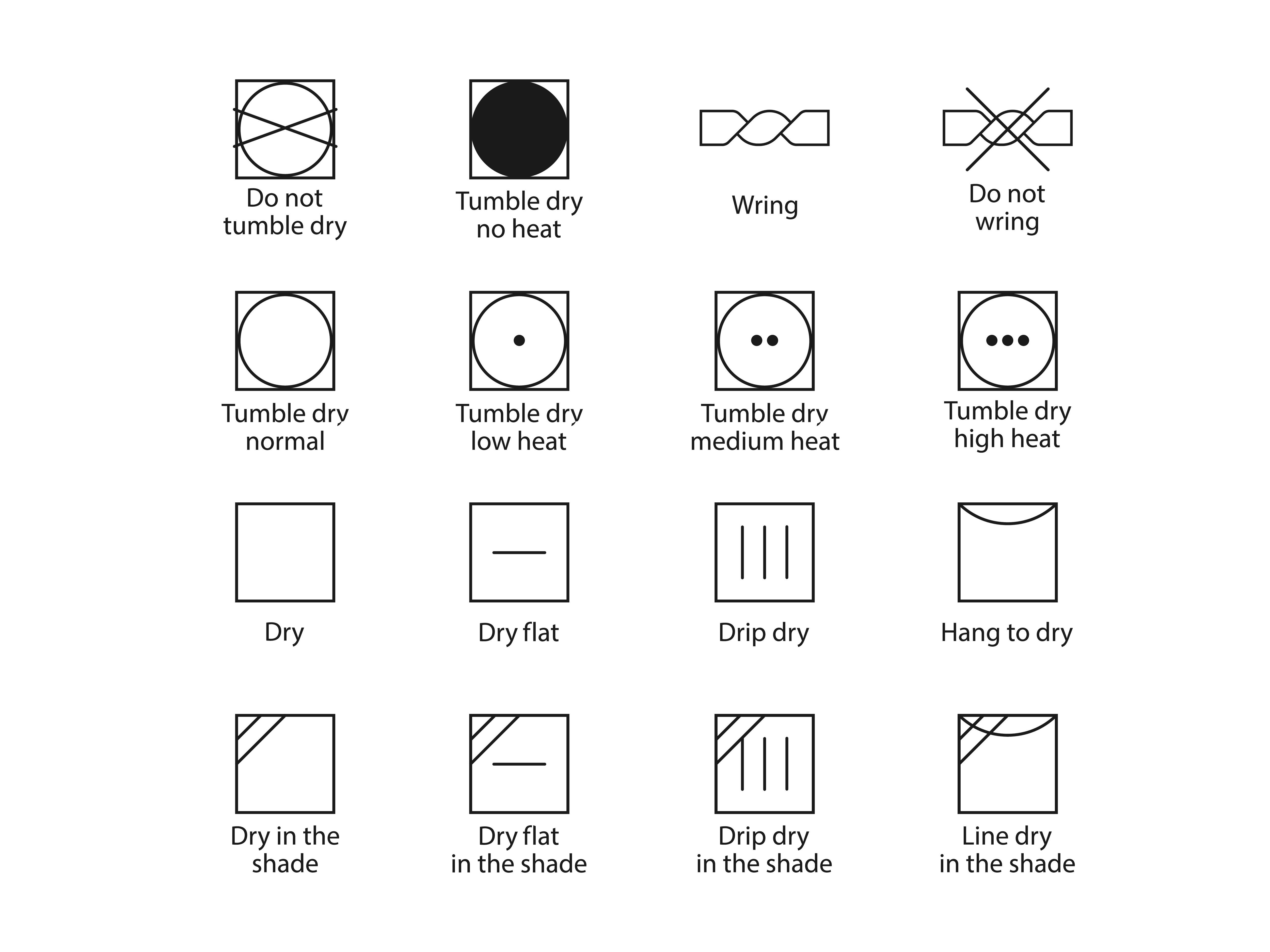
It's important to know what the laundry symbols mean when using the dryer, including familiarizing yourself with the tumble dryer temperature guide, as this is where many clothes are shrunk and damaged the most.
- A white circle in a square with a cross through it (far left, top row above) means you cannot tumble-dry the item. Instead, opt to air-dry your garment, either outdoors or on a clothes airer, such as the SONGMICS Clothes Drying Rack available at Amazon.
- A black circle in a square (second symbol, top row above) means you can tumble dry the item, but with no heat.
- A twisted rectangle (third symbol, top row above) means you can wring the item while wet.
- A twisted rectangle with a cross through it (far right, top row above) means do not wring the item while wet to avoid stretching.
- A white circle in a square (far left, second row above) means you can tumble dry as normal.
- A white circle in a square with a single dot (second symbol, second row above) suggests dry on low heat. Two dots means dry on medium, and three dots means tumble-dry on high.
- A white square with a single horizontal line (second symbol, third row above) means you should dry the item flat. This is most commonly found on natural fiber garments such as wool.
- A white square with three vertical lines (third symbol, third row above) means you should drip dry the garment. This is usually for items which cannot be tumble-dryed or wrung out.
- A white square with a half circle at the top (far right, third row above) means you should hang the item to dry. There are many benefits of air-drying laundry, from making laundry smell better to saving you money at home.
- A square with two lines slanted in the top left-hand corner (far left, fourth row above) suggests that the item should be dried in a shady area to prevent sun damage and fading. These slanted lines may be paired with other drying instructions, such as the horizontal line (second symbol, fourth row above) to suggest drying flat in the shade, or the half-circle (far right, fourth row above) to suggest hanging to dry in the shade.
Bleaching symbols
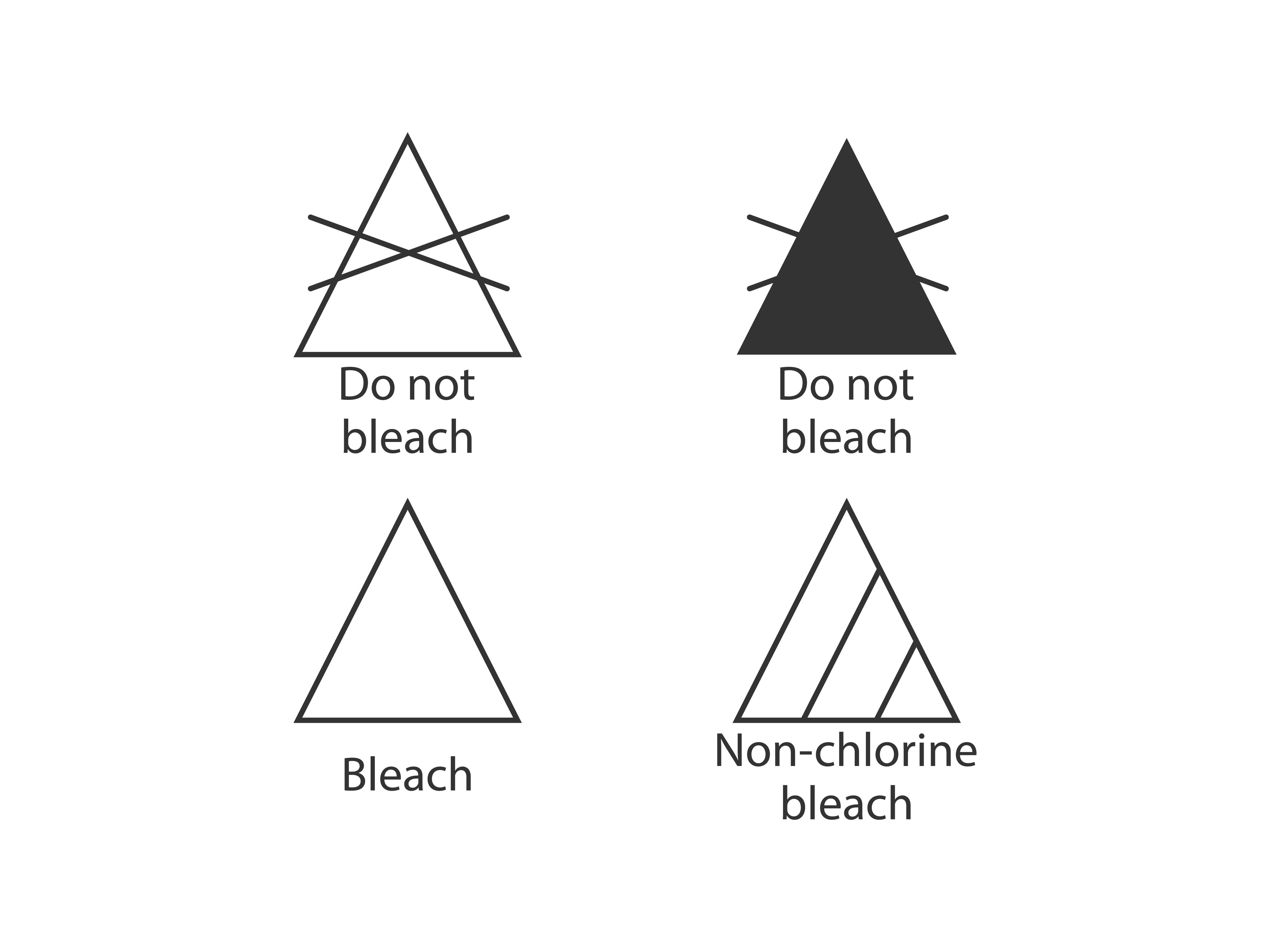
If you want to use bleach in laundry, check for the bleach laundry symbols beforehand. Some dyes and fabrics may have an adverse reaction to bleach if used incorrectly.
- A triangle with a cross (top row above) means do not bleach.
- A white triangle (bottom left above) means you can use bleach, which is a laundry hack to ensure white sheets stay white.
- A white triangle with two angled lines inside (bottom right) indicates only non-chlorine bleach should be used, such as OxiClean White Revive Laundry Whitener and Laundry Stain Remover Powder available at Walmart.
Ironing symbols
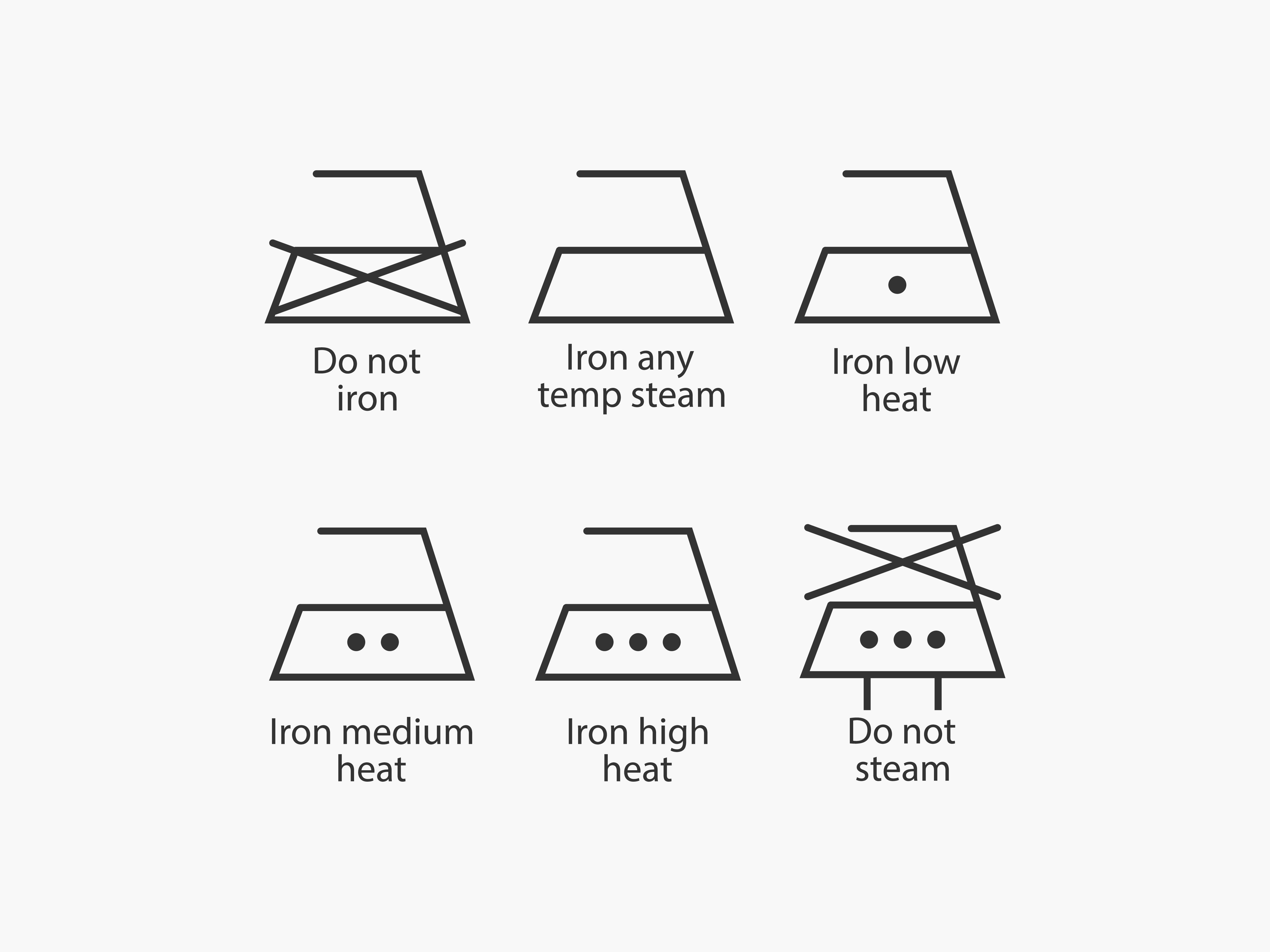
Ironing is one of the best ways to get wrinkles out of clothes, but there are a number of things you should never iron, as not every type of fabric can be exposed to direct heat or excessive steam. Therefore, it's as vital to get the heat right when it comes to ironing as it is for washing and drying.
- An iron icon with a cross over it (top left above) means do not iron. It is possible to unwrinkle clothes without an iron, using one of the best steam cleaners or a wrinkle-release spray, such as the highly rated Downy Crisp Linen Wrinkle Releaser Spray available at Target.
- An iron icon (centre, top row above) means the item can be ironed.
- An iron icon with a single dot (top right above) means the item can be ironed, but use low heat.
- An iron icon with two dots inside (bottom left above) means iron the item on a medium heat.
- An iron icon with three dots inside (bottom centre above) means high heat can be used on the item.
- An iron item with two vertical lines beneath and a cross over it (bottom right above) means the item can be ironed, but avoid the use of steam.
FAQs
How do you wash clothes without labels?
If your item does not have a care tag, attempt to identify the material of the garment. It is safest to hand wash these items, or wash them on a cool, delicate cycle with gentle detergent, such as the bestselling Tide Free & Gentle Liquid Laundry Detergent available at Walmart, and no fabric softener. Our three-step method for hand washing wool ensures your winter jumpers stay soft and cozy, without shrinking.
If the garment has an interesting texture, such as velvet, take it to your local dry-cleaners for professional advise on washing the fabric, as there are washing machine mistakes and laundry mistakes to avoid when caring for these types of garments.
What are the most important laundry rules?
If you're unsure whether you need to separate your laundry, this is one of the most important rules to follow for preventing color bleeding and fading. Also, always follow the care label, and never overload your washing machine or tumble dryer.
For the best results, learn how to clean your washing machine and do so every six months, and never delay in replacing your washing machine when the time comes. Not only will this prolong the life of your appliance, but will ensure that your clothes come out fresh every time, making the effort you put into understanding their care instructions worth it.
If you're wondering how long a washing machine lasts, there are warning signs it's time to replace your old appliances to look out for.
Sign up to the Homes & Gardens newsletter
Design expertise in your inbox – from inspiring decorating ideas and beautiful celebrity homes to practical gardening advice and shopping round-ups.

Ottilie joined Homes & Gardens last year, after finishing a Master's in Magazine Journalism at City, University of London. With previous contributions in Livingetc and Motorsport Magazine, she produces content for the Solved section on the website, focusing on clever tips and tricks to keep your home beautiful, organized and clean. She also has an undergraduate degree in English Literature and History of Art from the University of Edinburgh, where she developed a love for inspiring interiors and architecture.
- Millie HurstSection Editor
- Chiana DicksonContent Editor
- Sarah WarwickContributing Editor
-
 9 things you can clean with glycerin – this cheap and natural cleaner is perfect for indoor and outdoor use
9 things you can clean with glycerin – this cheap and natural cleaner is perfect for indoor and outdoor useFrom patio furniture to silverware, this hydrating and gentle cleaning agent will work miracles
By Ciéra Cree Published
-
 Martha Stewart's houses – inside her most iconic properties, from Cantitoe Corners to Turkey Hill
Martha Stewart's houses – inside her most iconic properties, from Cantitoe Corners to Turkey HillThe lifestyle guru built her legacy around her homes, some of which are the most recognized homes in modern American history – we explore her portfolio
By Megan Slack Published
-
 My cheap dehumidifier makes easy work of air drying laundry indoors despite the humidity of spring showers – get yours on sale for just $49 now
My cheap dehumidifier makes easy work of air drying laundry indoors despite the humidity of spring showers – get yours on sale for just $49 nowIt's useful for lots of things around my home
By Punteha van Terheyden Published
-
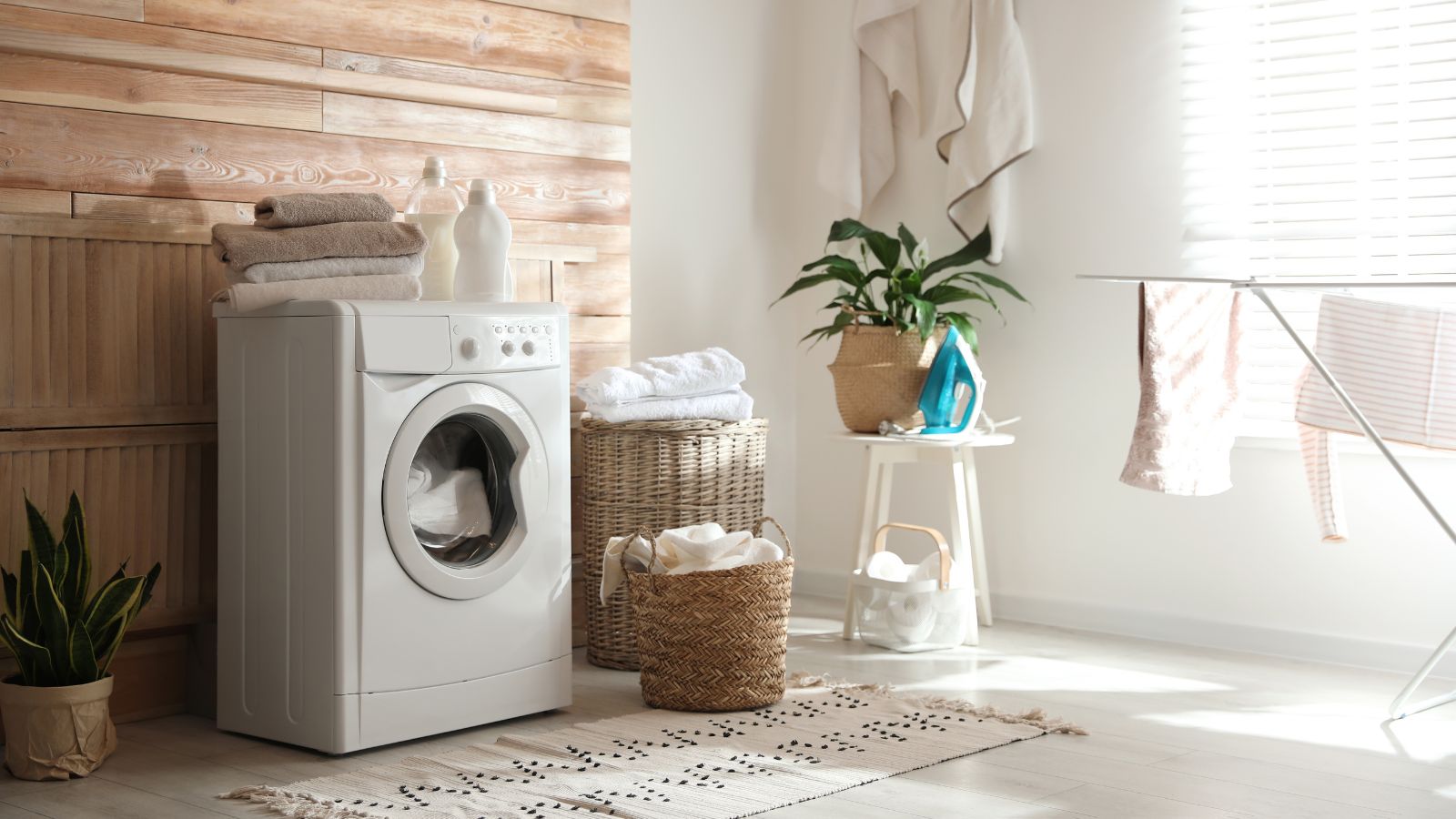 Looking for a natural laundry-softening alternative? I'm a professional cleaner and it's time to ditch synthetic ones for 5 non-toxic softeners that work
Looking for a natural laundry-softening alternative? I'm a professional cleaner and it's time to ditch synthetic ones for 5 non-toxic softeners that workRefresh your laundry routine with these fabric softener alternatives
By Karina Toner Published
-
 Unlock the magical mold-killing and stain-busting superpower of this humble household ingredient that costs just 50 cents
Unlock the magical mold-killing and stain-busting superpower of this humble household ingredient that costs just 50 centsIf you have aspirin in the house, you can use it to banish mold
By Ottilie Blackhall Published
-
 5 warning signs you're using the wrong amount of detergent – avoid greasy residue, stiff fabrics and skin issues with these simple cleaner-approved tips
5 warning signs you're using the wrong amount of detergent – avoid greasy residue, stiff fabrics and skin issues with these simple cleaner-approved tipsPlus, why it's important to get the amount just right
By Ottilie Blackhall Published
-
 6 ways to prevent mold and damp in bedrooms – expert solutions to maintain a safe sleep environment
6 ways to prevent mold and damp in bedrooms – expert solutions to maintain a safe sleep environmentDon't sleep on these six tips, experts urge
By Seraphina Di Mizzurati Published
-
 Laundry experts reveal 7 unexpected washing rules you can throw out the window – from separating fabrics to mixing whites and colors
Laundry experts reveal 7 unexpected washing rules you can throw out the window – from separating fabrics to mixing whites and colorsForget everything you thought you knew
By Ottilie Blackhall Published
-
 Using this button on your washing machine will cut your bills and help the planet
Using this button on your washing machine will cut your bills and help the planetA single switch can make a load of difference
By Chiana Dickson Published
-
 Experts reveal the 5 toxic items lurking in your laundry room – and what to swap them with for a healthier routine
Experts reveal the 5 toxic items lurking in your laundry room – and what to swap them with for a healthier routineFor a room focused on cleaning, some of its items can be surprisingly toxic
By Chiana Dickson Published